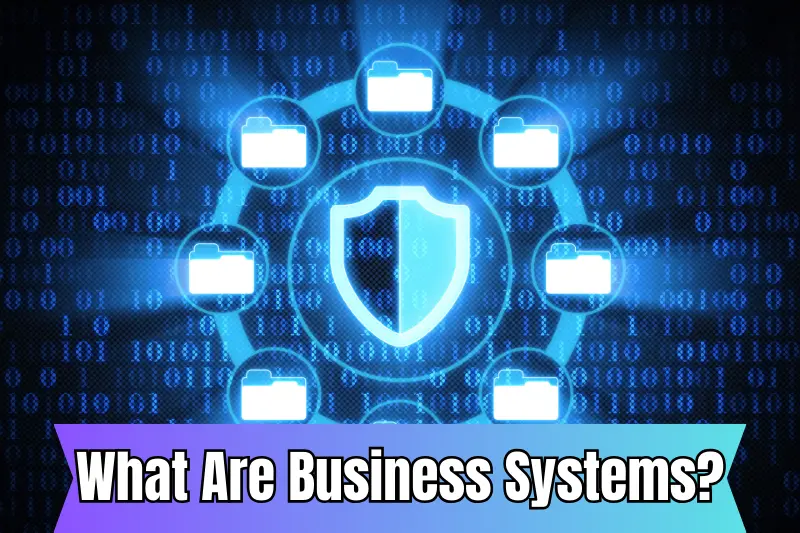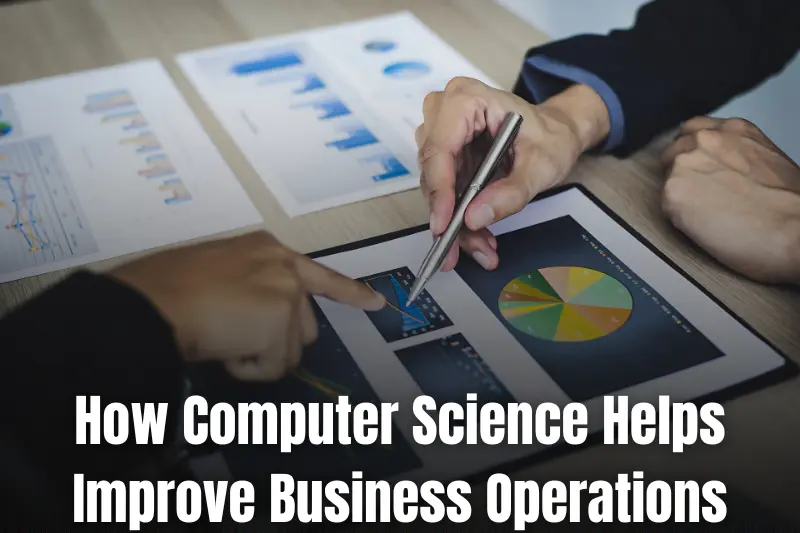Imagine trying to run a business without the help of modern technology. It’s hard to imagine how you’d manage everything from customer relationships to inventory and finances. Thankfully, with the rise of computer science, business systems have become more powerful and easier to integrate. Today, these systems are revolutionizing the way companies operate and grow in a digital world.
Computer science is the study of computers, programming, and algorithms that allow machines to perform tasks efficiently. Business systems refer to the processes and tools businesses use to manage operations, data, and interactions with customers. When combined, computer science and business systems create powerful solutions that drive modern businesses forward.
In today’s world, computer science and business systems play a vital role in enhancing productivity and solving everyday business challenges. By automating tasks, improving communication, and making data-driven decisions, businesses can run more smoothly and grow faster. Technology is no longer optional—it’s a key ingredient to staying competitive and efficient in any industry.
What Are Business Systems?

Definition of Business Systems
- A business system refers to the tools and processes that a company uses to carry out its operations smoothly.
- It includes the software, people, and procedures that help in managing everything from customer data to inventory and finances.
- Business systems help businesses organize tasks and make operations more efficient, allowing them to grow and scale effectively.
Types of Business Systems
Customer Relationship Management (CRM)
- What it is: CRM systems help businesses manage and improve their relationships with customers.
- How it works: It stores customer contact details, tracks interactions, and helps in following up on sales leads.
- Example: A company uses a CRM like Salesforce to track customer inquiries, making it easier to follow up and personalize offers.
Enterprise Resource Planning (ERP)
- What it is: ERP systems are used to manage core business functions like finance, HR, inventory, and supply chain in one unified platform.
- How it works: It streamlines processes across departments, so all parts of the business are on the same page.
- Example: A manufacturing company uses an ERP system like SAP to handle everything from payroll to raw material purchases, ensuring smooth operations.
Supply Chain Management (SCM)
- What it is: SCM systems help businesses manage the flow of goods and services, from raw materials to delivering the final product to customers.
- How it works: It tracks products as they move through the supply chain and helps businesses optimize inventory and reduce waste.
- Example: A retailer uses SCM software to track inventory levels, forecast demand, and reorder products to ensure they don’t run out of stock.
You may also like it:
Personal Finance Guide: Tips for Financial Success
Smart Home Trends: Top Innovations for 2025
Easy Budgeting Tips: Manage Your Money Smartly
The Role of Computer Science in Business Systems
Automation and Efficiency
- What it is: Computer science enables businesses to automate repetitive tasks, saving time and reducing the risk of human error.
- How it works: Using software and algorithms, businesses can set systems to handle tasks like payroll, inventory management, and scheduling automatically.
- Benefits: Automation leads to faster processes, fewer mistakes, and more time for employees to focus on creative or strategic work.
Example:
- Automated Emails: Many businesses use email marketing software like Mailchimp to send personalized emails automatically to customers based on their actions, such as abandoned cart reminders or special promotions.
- Chatbots for Customer Service: Many websites now have chatbots powered by AI that can respond to customer questions instantly, helping businesses offer 24/7 customer support.
Data Management and Analysis
- What it is: Data management and analysis involve collecting, organizing, and interpreting data to make informed business decisions.
- How it works: By using advanced software, businesses can track important data like sales trends, customer preferences, and inventory levels. This data helps businesses make decisions that lead to improved performance.
- Benefits: Data-driven decisions often lead to more targeted marketing, better inventory management, and personalized customer experiences.
Example:
- Data-Driven Marketing: Businesses use customer purchase history and browsing data to tailor marketing efforts. For example, Amazon uses data analytics to recommend products to users based on their previous purchases, increasing sales by offering relevant suggestions.
Software and System Development
- What it is: Software and system development refers to the process of creating custom software solutions that meet a business’s unique needs.
- How it works: Companies either build or purchase software systems to manage their operations, such as creating mobile apps or custom ERP systems. Developers continuously update and improve these systems to keep up with changing needs.
- Benefits: Custom software ensures businesses have the tools they need to operate smoothly, without relying on one-size-fits-all solutions.
Example:
- Order and Payment Apps: A retail company might develop a custom mobile app that allows customers to browse products, place orders, and make payments easily from their smartphones, improving customer satisfaction and sales.
Key Technologies Behind Business Systems
Cloud Computing
- What it is: Cloud computing allows businesses to store and access data and software applications over the internet, instead of using local computers or servers.
- How it works: Data and software are hosted on remote servers, which users can access from any device with an internet connection.
- Benefits: Cloud services provide flexibility, reduce the need for physical storage, and ensure data is available from anywhere.
Example:
- Google Drive & Dropbox: These cloud storage services let businesses and individuals store files online, share documents, and collaborate with others easily without needing large physical servers.
Big Data and Analytics
- What it is: Big data refers to massive amounts of data that businesses collect from various sources. Analytics involves examining this data to find patterns, trends, and insights.
- How it works: Businesses use specialized tools to process and analyze large datasets, helping them make better decisions based on real information.
- Benefits: Big data allows businesses to better understand customer behavior, predict future trends, and optimize operations.
Example:
- Amazon’s Product Recommendation System: Amazon uses big data to analyze customers’ browsing and purchase history. Based on this, they recommend products to users, boosting sales and improving the shopping experience.
Artificial Intelligence (AI) and Machine Learning
- What it is: AI is the simulation of human intelligence in machines that can learn and make decisions. Machine learning is a subset of AI that allows systems to learn from data and improve over time.
- How it works: AI and machine learning systems use data to identify patterns and make predictions or decisions without human intervention.
- Benefits: These technologies can automate tasks, enhance customer experiences, and help businesses make smarter, data-driven decisions.
Example:
- AI-Powered Customer Support Systems: Many companies use AI-driven chatbots or virtual assistants to provide instant customer support, answer frequently asked questions, and resolve common issues, saving time and resources.
How Computer Science Helps Improve Business Operations

Increasing Productivity
- What it is: Computer science helps businesses improve productivity by using software tools to streamline tasks and automate processes.
- How it works: These tools allow businesses to manage multiple tasks at once, communicate more effectively, and reduce time spent on manual work.
- Benefits: Increased productivity leads to faster project completion, fewer errors, and more efficient use of resources.
Examples:
- Trello: A project management tool that helps teams organize tasks and track project progress, ensuring everyone stays on the same page.
- Slack: A communication tool that allows businesses to have real-time conversations, share files, and integrate with other software, reducing email clutter and speeding up collaboration.
Enhancing Customer Experience
- What it is: Technology allows businesses to improve customer service and satisfaction by offering tailored products, services, and support.
- How it works: By collecting and analyzing customer data, businesses can better understand customer preferences, behaviors, and needs. This helps them create personalized experiences that meet individual expectations.
- Benefits: Enhancing customer experience increases loyalty, boosts sales, and improves brand reputation.
Example:
- Online Shopping Platforms Offering Personalized Product Suggestions: E-commerce sites like Amazon or Netflix use data-driven algorithms to recommend products or movies based on past purchases or viewing history, making the shopping or browsing experience more relevant and enjoyable for users.
Challenges in Implementing Computer Science in Business
High Initial Costs
- What it is: Setting up new technology systems can be expensive for businesses, especially when it involves purchasing software, hardware, and subscribing to cloud services.
- How it works: Businesses need to invest in infrastructure such as servers, software licenses, and cloud storage before they can benefit from advanced technologies.
- Challenges: These costs can be a barrier for small businesses or startups, making it difficult for them to access the latest technology.
Example:
- Software and Cloud Services: A business might need to pay upfront for software like an ERP system or subscribe to cloud services like Amazon Web Services (AWS) or Microsoft Azure, which can add up quickly.
Security Risks
- What it is: As businesses collect more data and use online systems, they face higher risks of cyberattacks and data breaches.
- How it works: Sensitive business data, like customer details and financial records, are stored in digital systems. Without proper security measures, these can be targeted by hackers or malicious software.
- Challenges: A single data breach can lead to financial losses, damage to reputation, and legal consequences.
Example:
- Recent Data Breaches: High-profile breaches like the Equifax data breach exposed millions of people’s personal data. To protect themselves, businesses need strong cybersecurity measures like encryption, firewalls, and regular security updates.
Training and Adoption
- What it is: Introducing new technology requires employees to learn how to use it effectively, which can be time-consuming and costly.
- How it works: Employees may struggle with adapting to new software or systems, leading to a temporary dip in productivity.
- Challenges: Without proper training, businesses risk underutilizing new technology, which can delay the expected benefits.
Example:
- Training Employees to Use New Business Software: When a company implements a new customer relationship management (CRM) system, employees must be trained on how to input data, use features, and troubleshoot problems. If training is not done correctly, the company may face lower efficiency or mistakes.
Future Trends in Computer Science and Business Systems
Blockchain Technology
- What it is: Blockchain is a decentralized and secure way to record transactions and track assets across multiple computers. It’s a digital ledger that is difficult to alter, ensuring transparency and security.
- How it works: Blockchain records transactions in “blocks” that are linked together, forming a chain. Each transaction is verified by multiple parties, making fraud or tampering very difficult.
- Benefits: Blockchain improves security, reduces fraud, and increases transparency in business processes like financial transactions and supply chains.
Example:
- Cryptocurrency and Secure Transactions: Bitcoin is a well-known cryptocurrency that uses blockchain to enable secure, decentralized transactions. In supply chains, blockchain helps track the movement of goods, ensuring that products are not tampered with and improving trust between suppliers and customers.
Internet of Things (IoT)
- What it is: The Internet of Things (IoT) refers to a network of smart devices that communicate with each other through the internet. These devices collect and exchange data to improve efficiency and decision-making.
- How it works: IoT devices are embedded with sensors and software that allow them to send and receive data. Businesses use this data to monitor performance, automate tasks, and improve operations.
- Benefits: IoT helps businesses optimize resources, improve customer experiences, and make data-driven decisions in real-time.
Example:
- Smart Thermostats: In offices or warehouses, IoT-enabled smart thermostats can adjust temperatures automatically based on occupancy, saving energy costs and improving employee comfort. Additionally, businesses can monitor and control these devices remotely for greater efficiency.
Conclusion
So guys, in this article, we’ve covered computer science and business systems in detail. As technology continues to evolve, I highly recommend that businesses start exploring how these systems can streamline operations and improve efficiency.
Investing in the right tools can provide long-term benefits, helping you stay competitive in a digital world. If you haven’t already, take the first step today—research the systems that could help transform your business.
FAQs about Computer Science and Business Systems
What exactly is a business system?
A business system refers to the processes and tools that help businesses operate efficiently. This includes software, procedures, and resources used to manage tasks like customer relations, inventory, and finances. These systems are designed to improve productivity and ensure smooth day-to-day operations.
How does computer science impact business operations?
Computer science provides the technology that automates tasks, stores data, and analyzes information, making business operations faster and more efficient. It helps reduce human error, increases productivity, and ensures better decision-making. Businesses rely on computer science for everything from customer service to inventory management.
What are some examples of business systems?
Common business systems include Customer Relationship Management (CRM) systems, Enterprise Resource Planning (ERP) systems, and Supply Chain Management (SCM) systems. CRMs help track customer interactions, ERPs manage various business functions, and SCM systems handle the flow of goods. These systems help businesses streamline operations and improve service.
How does cloud computing help businesses?
Cloud computing allows businesses to store and access data over the internet rather than on local computers or servers. It’s cost-effective, flexible, and accessible from anywhere. Services like Google Drive or Dropbox let businesses collaborate and store files securely online without needing physical infrastructure.
What is big data and how does it benefit businesses?
Big data refers to large volumes of data that businesses collect from various sources. By analyzing this data, businesses can uncover trends and insights to make better decisions. For example, retailers use customer data to personalize shopping experiences and improve sales strategies.
How does artificial intelligence (AI) improve customer service?
AI enhances customer service by automating responses and personalizing interactions. Chatbots, for instance, can answer customer questions instantly, 24/7, without human intervention. This reduces wait times and ensures customers get fast, accurate responses.
What are the main challenges of using computer science in business?
Some
Some challenges include high initial costs for setting up new technology, security risks with data, and the need for employee training. Implementing new systems can be expensive and time-consuming, especially for small businesses. Businesses also need to protect data from cyber threats and ensure employees know how to use new technologies.
What is blockchain technology and how does it affect business?
Blockchain is a secure, decentralized system for recording transactions and tracking assets. It’s especially useful in industries like finance and supply chain management for secure, transparent transactions. Businesses use blockchain to reduce fraud and ensure the integrity of data.
You may also like it:
Saving Money Tips for Students: Master Your Finances Now!
Startup Marketing Strategies: Boost Your Business Fast







